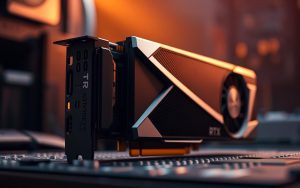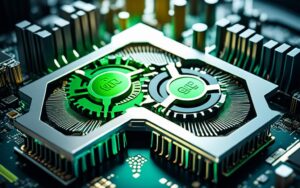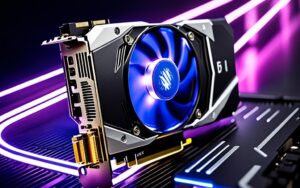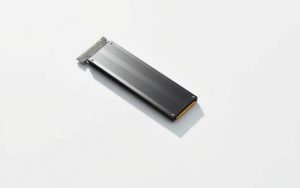Table of Contents
The latest generation of PCIe 5.0 hardware brings blazing-fast speeds, doubling the bandwidth of PCIe 4.0. But what if your motherboard only supports the older standard? The good news is, newer devices will still fit and function—just at reduced performance.
Backward compatibility ensures that a PCIe 5.0 GPU or SSD physically connects to a PCIe 4.0 slot. However, the device operates at the slower speeds of the older standard. This trade-off means you won’t get peak performance unless both your CPU and motherboard support the newer tech.
Real-world impacts vary. High-end GPUs and NVMe drives see noticeable differences, while everyday tasks may feel unchanged. Future-proofing depends on your hardware setup and upgrade plans.
Understanding PCIe Generations and Their Differences
Modern computing relies heavily on high-speed data transfer. The PCIe (Peripheral Component Interconnect Express) standard is the backbone for connecting graphics cards, SSDs, and other peripherals. Each generation brings faster speeds, improving overall system performance.
What Is PCIe and Why Does It Matter?
This interface determines how quickly components communicate with your CPU. More lanes (x1, x4, x8, x16) mean higher throughput. For example, a graphics card typically uses an x16 slot for maximum bandwidth.
PCIe 4.0 vs. 5.0: Key Technical Improvements
The jump from Gen4 to Gen5 doubled transfer rates—from 16 GT/s to 32 GT/s per lane. This means a single Gen5 lane delivers 4 GB/s, while Gen4 offers 2 GB/s. Real-world benefits include faster load times and smoother multitasking.
How Bandwidth Scales Across PCIe Versions
Total bandwidth depends on lane count and generation. A full x16 Gen5 slot provides 128 GB/s, compared to 64 GB/s for Gen4. Enterprise solutions like Nvidia’s 400G OSFP adapters leverage this for high-speed networking.
| Generation | Transfer Rate (GT/s) | Bandwidth per Lane (GB/s) |
|---|---|---|
| PCIe 4.0 | 16 | 2 |
| PCIe 5.0 | 32 | 4 |
Upgrading to newer generations future-proofs your system. However, compatibility ensures older devices still function, albeit at reduced speeds.
Can PCIe 5.0 Work with 4.0? Backward Compatibility Explained
Next-gen hardware often raises compatibility questions. The good news: PCIe 5.0 devices fit into older slots without issues. However, they operate at PCIe 4.0 speeds, capping potential performance gains.

Multi-device setups need careful planning. Modern CPUs like Intel’s 12th/13th Gen allocate limited lanes:
| Component | Gen5 Lanes | Gen4 Lanes |
|---|---|---|
| Primary GPU Slot | 16 | 0 |
| Secondary Slots (SSD/GPU) | 0 | 20 |
This means adding a Gen5 SSD might share bandwidth with other cards, causing bottlenecks. Always check your motherboard manual for lane distribution.
Future-proofing is simpler with PCIe 6.0, which retains backward compatibility. But adoption will take time, making Gen5 the current focus for upgrades.
Performance Implications of Using PCIe 5.0 in 4.0 Slots
Newer hardware often delivers impressive specs, but real-world results depend on your system’s capabilities. When using PCIe 5.0 devices in older slots, performance varies significantly between components. Understanding these differences helps optimize upgrades.
Real-World Speed Differences for GPUs and SSDs
NVMe SSDs show the most dramatic changes. A PCIe 5.0 SSD in a Gen4 slot caps at ~8 GB/s, half its potential speed. For tasks like 4K video editing, this bottleneck slows rendering times.
Current graphics cards rarely max out Gen4 x16 bandwidth. However, next-gen GPUs may leverage Gen5’s higher throughput for ray tracing or AI workloads. Until then, the difference remains minimal for gaming.
| Component | PCIe 4.0 Speed | PCIe 5.0 Speed (in Gen4 Slot) |
|---|---|---|
| NVMe SSD | 8 GB/s | 8 GB/s (capped) |
| High-End GPU | 64 GB/s (x16) | 64 GB/s (x16) |
When Upgrading to PCIe 5.0 Makes Sense
Data centers and content creators benefit most. Doubled SSD speeds reduce time for large file transfers. For gamers, upgrading the motherboard and CPU for Gen5 may not justify costs yet.
Future-proofing matters if you plan to adopt next-gen GPUs or high-bandwidth peripherals. Otherwise, Gen4 remains cost-effective.
Motherboard and CPU Limitations to Consider
Even with a Gen5-ready motherboard, lane distribution affects performance. Many Z690/Z790 chipsets share lanes between slots, reducing available bandwidth for multi-device setups.
Power delivery also plays a role. The new 16-pin connector supports 600W, essential for high-end graphics cards. Ensure your PSU and cooling can handle these demands.
Conclusion
Upgrading hardware involves balancing speed with compatibility. While PCIe 5.0 slot devices fit older slots, they run at reduced speeds. Most users won’t need the extra bandwidth until 2024-2025.
Key topics to consider: CPU lane allocation, motherboard support, and workload demands. High-end setups, like AI or machine learning, benefit most from a 5.0 slot.
Future advancements, like PCIe 6.0, will push speeds further. For now, evaluate your needs before investing in the latest card or storage. Smart planning saves time and money.
FAQ
Are PCIe 5.0 devices compatible with 4.0 slots?
Yes, PCIe 5.0 hardware works in 4.0 slots due to backward compatibility. However, bandwidth is limited to the older standard’s capabilities.
What are the main differences between PCIe 4.0 and 5.0?
The newer version doubles the bandwidth (32 GT/s vs. 16 GT/s), improving data transfer speeds for GPUs and NVMe SSDs.
Will a PCIe 5.0 GPU perform worse in a 4.0 slot?
Current high-end graphics cards like NVIDIA’s RTX 4090 or AMD’s RX 7900 XTX show minimal performance loss, as they don’t fully saturate 4.0 bandwidth.
Do I need a new motherboard for PCIe 5.0 support?
Only if you require maximum bandwidth. Existing 4.0 motherboards from brands like ASUS or MSI will still function but limit potential speeds.
How does PCIe backward compatibility work?
The interface automatically negotiates the highest mutually supported version between the device and slot, ensuring seamless operation.
Are there real-world benefits to upgrading to PCIe 5.0 now?
For most users, no—current SSDs and GPUs don’t leverage the full bandwidth. Early adopters may see advantages with specialized workloads.









